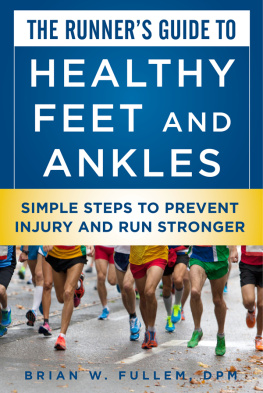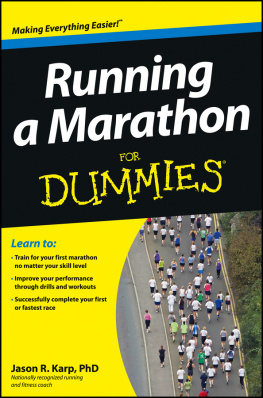All rights reserved.
No part of this publication may be copied,reproduced in any format, by any means, electronic or otherwise, without priorconsent from the copyright owner and publisher of this book.
Introduction
If you are a runner and you choose not to doany form of strength training then you are going to increase the chances ofhaving to stop as you develop some kind of injury.
Many runners that do not believe that liftingweights is crucial are sadly mistaken. In fact even though running itself maynot actually cause an injury it does help to highlight any weaknesses that youhave and which may prevent you from seeing any improvements taking place eventhough you may be running every day. There is no better way to determine whatneeds to be done to improve our bodies than by listening to it when out runningand making changes.
If you are able to pinpoint your weaknessesthen you can work on strengthening them in the early part of your runningcareer. It will also help to make your musculoskeletal system far stronger,which in turn will help make your life much more rewarding later on because youare likely to be virtually free of any kind of pain.
The major problem that the majority ofrunners are faced with when deciding to take up strength training is that theyhave no idea of what form they should take up, when it should be done and howit should be done. It is for this reason I have decided to write this book tohelp you create the perfect strength training for runners program for you.
When it comes to creating the perfectstrength training program for you there are certain basic key features thatneed to be followed. First you must make sure that your program ensures thatyou are lifting weights. Second you must make sure that you are lifting weightsconsistently and finally you must make sure that you are lifting weightscorrectly and at the right intensity.
When I talk about you lifting weightsconsistently what I mean is that you should be lifting weights at least 2 or 3times each week over a period of several months. This will then help you tobuild the right strength base.
Whereas when I am talking about you liftingweights correctly I am referring to you performing each exercise to build upstrength in your body safely as well as in the most effective way possible.This means lifting the weights using the right techniques with the right amountof muscle control.
Finally when I talk about you lifting weightsusing the right intensity it relates to the actual amount of weight that youare using for each exercise. Also it relates to how difficult each exercise isduring each training session you undertake.
There are several reasons why anyone whoenjoys distance running should improve their overall strength in relation totheir upper body and legs.
Reason 1 - You will find it easier managingworkloads that are far more intense.
Reason 2 - The much stronger your muscularstrength then of course the risk of you causing injury to your joints isreduced as you are placing less stress on their connective tissue such as theligaments, tendons and cartilage. You will also find that this form of traininghelps to maintain the integrity of the joints.
Furthermore a good strength training programfor runners will help to reduce the severity of the injury should one developin the future.
Reason 3 - Using a progressive resistanceprogram will help to strengthen the connective tissue and as a result of thebodys entire support system becomes more durable.
Reason 4 - Not only does strength traininghelp to reduce the risk of you injuring yourself when running, but it also canhelp to improve your performance. In a few studies carried out it has beenshown that doing as little as 10 weeks of strength training can help you toreduce the time it takes you to run 10K by over a minute.
Reason 5 - As well as seeing improvements inhow fast you can run you will notice that the amount of oxygen your body isable to take in also increases. As you are able to take in more oxygen you willfind that over certain distances you wont start to feel so tired so quickly.
So as you can see from above there are plentyof reasons why you must include some form of strength training into yourrunning program each week.
Chapter 1 Developing AndSetting Up Your Strength Training Program
Intelligent strength training for runners isbased upon periodization. This actually allows you to gradually incorporateblocks of strength training into your running program that are of differentlevels of intensity and specificity, in order that you are able to reach peaklevels of fitness.
In a book by Dave Martin PhD entitled BetterTraining For Distance Runners he describes the three periods of strengthtraining. The first period is that known as the Macrocycle. This is thedevelopment stage of your strength training program and needs to be undertakenfor quite a period of time for you to be able to reach your maximum fitness levels.In most cases you will find that a year spent on this part of your training iswhat is needed to achieve better endurance.
The Macrocycle is then divided up into anumber of smaller periods of development called Mesocycles. Each of theseperiods of development come with their own objectives to be reached, such ashelping to increase your lactate threshold or to help increase strength. Eachof these cycles can last from just a few weeks to a few months and all of theseMesocycles will consist of at least one Microcycle.
During each Microcycle which will lastroughly for two weeks is made up of training that provides balanced developmentto your body as a whole.
As for strength training for runners this canbe divided into three time periods, Pre-Season, In-Season and Post-Season.During these periods changes occur relating to the volume and number of sets ofeach exercise performed in order to keep pace with the different demands placedon the runner through these three periods.
It is important to make sure that runnerscarrying out strength training during the Pre-Season period ensure that theygain the most benefits from it. It is at this time they need to be maximizingtheir strength for any races they may be entered in or if they intend to do agreat deal of running during the season. At this time the number of reps theyshould be completing should be the highest they can possibly manage. But alsocompliments how much less running they will be doing at this time.
When it comes to trying to increase theirstrength they should be aiming to complete three sets of each exercise with arest of 2 minutes between each set. Plus they should be aiming to be able tocomplete 5 or 6 reps of each exercise in each set as this has been shown to bethe most effective way to improve strength in runners.
However when it comes to strength trainingone of the biggest mistakes often made by runners is to carry out each set ofreps using a weight that isnt that heavy. When it comes to determining justhow much weight they should be lifting they need to be aware that it is a trialand error process. The best way to determine if they are lifting enough weightis that once they have finished the last rep and they feel like they wont beable to do another one then they are lifting sufficient amounts of weight.However if they feel that the last rep was easy then they should think aboutadding an additional 5 to 10% extra weight on to what they are already lifting.

During the Pre-Season period it is okay to dostrength training only 2 to 3 times a week. This will then ensure that theirbody has been provided with sufficient time to recover after each workout hasbeen completed.

















